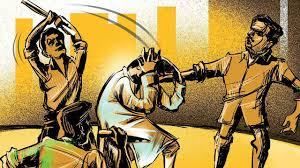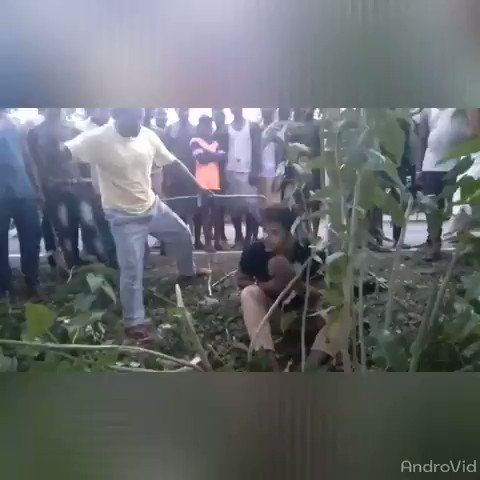Mob Lynching In India (Latest 2019)
Jun 25, 2019 • 22 views
MOB LYNCHING :-Lynchingis a premeditated extrajudicial killing by a group, and may be considered a Presumption of guilt. It is most often used to characterize informal public executions by amobin order to punish an alleged transgressor, or to intimidate a group. The term lynch law refers to a self-constituted court that imposes sentence on a person without due process of law. In other words alynch mobis an angrycrowdof people who want to kill someone without a trial, because they believe that person has committed a crime.

The Making of Lynchistan: Inside India’s Deadly ‘Gau Raksha’ Network
Since the lynching of Mohd Akhlaq in September 2015 in Dadri, there have been more than 35 lynchings related to cattle vigilantism, in 11 states across India. Why is it that#moblynchingin India have become the new normal? And how exactly does#Lynchistanoperate? Here’s an inside view of the lethal#cowvigilantisminfrastructure.
RECENT CASE
Jharkhand: Muslim man beaten up on suspicion of theft, forced to chant Jai Shree Ram, succumbs to injuries.
The victim has been identified as 24-year-old Tabrez Ansari. Several videos of the Jharkhand mob lynching have gone viral since the incident. In one of the videos, a man is seen hitting Tabrez Ansari with a wooden stick as the latter begs him to let him go.

Tabrez Ansari worked in Pune as a welder and a labourer and had come to his village in Jharkhand’s Kharsawan district to celebrate Eid with his family.
HIGHLIGHTS
Tabrez Ansari succumbed to his injuries at a local hospital on June 22
In one of the videos, a man is seen hitting Tabrez Ansari with a wooden stick
Another video showed Tabrez being forced to chant “Jai Shri Ram” and “Jai Hanuman”

RISING MOB VIOLENCE IN INDIA
For the past 18 years, India has been witnesses an unusual increase in crime related to mob violence, in the name of religion, kidnapping etc. Though, the epidemic spread in the form of vigilant against cow slaughter, later in spread to kidnapping and other sorts of crimes. According to unofficial estimates around 120 people have killed through the country.

What are the reasons?
Rise of cow vigilante
Even since, Government imposed a ban on the sale and purchase of cattle for slaughter at animal markets across India, under Prevention of Cruelty to Animals statutes (26th May 2017), it sparked a new wave of cow vigilante in the country. Though the Supreme Court, suspended the ban on the sale of cattle in its judgment in July 2017, giving relief to the multi-billion dollar beef and leather industries and several states where beef is one among the primary foods there was a rise in attacks on Muslims accusing them as beef eaters. Several dozen innocent Muslims were killed in such mob attack. But human rights experts fee mob lynching is not a right and the apt term description of such violence, they seek to highlight the organisations or group of vicious individuals who are instigating such incidents. These incidents are usually appearing to be sporadic in nature and often a spontaneous response from the Hindus who are generally furious over the reports of cow smuggling and slaughter. But mostly it is not.
Silence of political class
Despite the rising mob violence, the political class and bureaucracy continued remain a silent spectator. The human rights observers, feel political class in behind the rise mob lynching since most of the people who are ruling the country retained or captured the power through political system which aggressive and violent. Besides, they have built their political career propagating violence against minorities, where the mobs feel empowered and strong. The political class, apart from their customary condemnation, they avoid visiting the victims or their surviving families.
Rumours of child lifters
Rumours of child kidnappers proved to an ignition point for mob violence, where WhatsApp posts were circulated Odisha, Tamilnadu, Gujarat, Karnataka, Telangana, Tripura and West Bengal. This claimed several lives on domestic visitors, mentally deranged peoples and incited numerous mob attacks. According to various reports, at least 20 persons have been killed and several injured in incidents of mob violence sparked by rumours of child kidnapping in 10 states for the past three months. Lack of proper policing
The incidents of mob violence, sparked by rumours about child lifters are totally connected lack of public confidence in the police. Common man feels police lack the ability to track down the criminals and recover the kidnapped children. According to home ministry figures, 54,723 child kidnapping cases (2016), 41,893 cases (2015), 37,854 cases (2014).It was found that the police filed charges against the kidnappers in only 40 per cent cases in 2016 and around 23 per cent of the cases decided in 2016. Practically speaking around three out of four people put to trial for child kidnapping walked free. Besides, state governments should be vigilante and try to prevent mob violence triggered by rumours. One way could be to keep detect rumours circulating on social media in their respective areas well before the public vents its anger and frustration at the innocent individuals.
Government initiatives
A)Creation of nodal officers
Central government on its part has asked states to appoint a nodal officer in each district to prevent the incidents of mob violence and lynching. In its advisory, the Home Ministry said, the nodal officer should be of superintendent of police-level officer. It has also asked to set up a special task force to procure intelligence reports about the people who are likely to commit such crimes or who are involved in spreading hate speeches, provocative statements and fake news. Home Ministry said, the process of identification should be done within a period of three weeks. The Ministry said, wherever it is found that a police officer or an officer of the district administration has failed to comply the directions to prevent such crime of mob violence and lynching, it should be considered as an act of deliberate negligence and misconduct and strong action must be taken against the official concerned. The advisory has been sent to the states and Union territories following a Supreme Court directive issued in this regard on 17th of this month.
Home Ministry asked state governments to implement the directions of the Supreme Court in letter and spirit. The Ministry said, police should register FIR against persons who disseminate irresponsible and explosive messages and videos having content which is likely to incite mob violence and lynching of any kind.
B) Creation of Two high level committees
Two high-level committees have been constituted by the Central government to suggest ways and legal framework to effectively deal with incidents of mob violence and lynching. One of the committees is being headed by Union Home Minister Rajnath Singh and the other by Union Home Secretary Rajiv Gauba. The move came a week after the Supreme Court asked the Central government to enact a law to deal with incidents of lynching and take action on mob violence. The government respects the recent directions of the Supreme Court on the issue of mob violence and has issued an advisory to State governments urging them to take effective measures to prevent incidents of mob violence and lynching, and take stringent action as per the law. In order to formulate appropriate measures to address the situation, the government has set up a high-level committee chaired by Union Home Secretary Gauba to deliberate upon the matter and make recommendations. The Secretaries of the justice, legal affairs, legislative, and social justice and empowerment departments are members of the committee. The committee will submit its recommendations to the government within four weeks. The government has also decided to constitute a Group of Ministers (GoM) headed by Home Minister Singh to consider the recommendations of the high-level committee of the Secretaries. External Affairs Minister Sushma Swaraj, Road Transport Minister Nitin Gadkari, Law Minister Ravi Shankar Prasad and Social Justice and Empowerment Minister Thawar Chand Gehlot are members of the GoM. The GoM will submit its recommendations to Prime Minister Narendra Modi.
To end mob lynching, Supreme Court gives an 11-point prescription
Mob lynchings: The top court gave a a slew of directions, including preventive, remedial and punitive steps, to deal with the crime.

The Supreme Court on 18th June, 2019condemned mob lynching incidentsacross the country and urged Parliament to enact a law to deal with the crime that threatens rule of law and the country’s social fabric.
Here’s a slew of directions, including preventive, remedial and punitive steps, the top court gave to deal with the crime:
* The state governments shall designate a senior police officer in each district for taking measures to prevent incidents of mob violence and lynching.
* The state governments shall immediately identify districts, sub-divisions and villages where instances of lynching and mob violence have been reported in the recent past.
* It shall be the duty of every police officer to cause a mob to disperse, which, in his opinion, has a tendency to cause violence in the disguise of vigilantism or otherwise
* The nodal officers shall bring to the notice of the DGP any inter-district co-ordination issues for devising a strategy to tackle lynching and mob violence related issues.
* Central and the state governments should broadcast on radio and television and other media platforms including the official websites that lynching and mob violence shall invite serious consequence .

* Curb and stop dissemination of irresponsible and explosive messages, videos and other material on various social media platforms. Register FIR under relevant provisions of law against persons who disseminate such messages.
* Ensure that there is no further harassment of the family members of the victims.
* State governments shall prepare a lynching/mob violence victim compensation scheme.
*To set a stern example in cases of mob violence and lynching, the trial court must ordinarily award maximum sentence upon conviction of the accused person.
* Cases of lynching and mob violence shall be specifically tried by designated court/fast track courts earmarked for that purpose in each district. The trial shall preferably be concluded within six months.
*If it is found that a police officer or an officer of the district administration has failed to fulfill his duty, it will be considered as an act of deliberate negligence.
Mob Lynching: Never Mind WhatsApp, Only These Measures Can Stop The Mobs
Yet another innocent man has lost his life to mob lynching instigated by a WhatsApp rumour. Last week in the Bidar district of Karnataka, a rumour on WhatsApp circulated about potential child kidnappers in the area led angry mobs to kill 32-year-old software engineer Mohammad Azam, and severely injure three other people. The police have arrested 34 people linked to the murder.
Over the past few weeks, the instant messaging service has taken some flak from the Centre after a spate of lynching-related deaths facilitated by rumours spread through the app.
Yet another innocent man has lost his life to mob lynching instigated by a WhatsApp rumour. Last week in the Bidar district of Karnataka, a rumour on WhatsApp circulated about potential child kidnappers in the area led angry mobs to kill 32-year-old software engineer Mohammad Azam, and severely injure three other people. The police have arrested 34 people linked to the murder.
Admittedly, the Facebook-owned app should and will implement other safeguards against the proliferation of such inciting messages in the following weeks, but it won’t solve the problem of mob lynchings. That’s because WhatsApp isn’t the problem; the issue is the lack of state capacity.
It goes without saying that deaths due to mob lynching have long occurred in India. What do you think happened in all those horrific riots of the past?
The only difference today is the speed at whichrumoursare circulated on the messaging app. What remains unchanged is the state’s inability to maintain itsmonopoly on violence,leaving mobs to meet out their deluded form of ‘justice.’

Spoiler alert: The criminals attempt an escape, get caught and are beaten to death by the mob.
This is done because of the lack of faith in the police and the judicial system, and the inability of the state to establish a monopoly over violence in a democracy.
Instead of pointing the blame atWhatsApp, ourpolitical classcan do better by addressing some fundamentalpolicing concerns. After all, apps likeWhatsApp, Facebook and Twitterare just mediums. Do you want the government to ban WhatsApp and other apps with end-to-end encryption? Do you want the government to monitor family conversations or an exchange with a loved one?
I don’t, and frankly, if we go down this road of laying all the blame on WhatsApp’s door instead of asking the right questions of our political class, we may see the government implementing the above steps. And frankly, those steps solve nothing.
MOB LYNCHING IS A NATIONAL CRIME – STOP LYNCHING
The source is taken from Hindustan Times, India News, Twitter and from YouTube.
